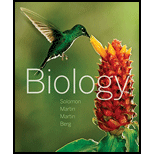
Concept explainers
Population _______________ is the number of individuals of a species per unit of habitat area or volume at a given time. (a) dispersion (b) density (c) survivorship (d) age structure (e) demographics
Introduction: The study of change in population is termed as population dynamics. Population ecology can be defined as both the number of individuals for a particular species in an area and dynamics of the population. It is the study of interaction of population with the environment, such as competition of individuals for food and other resources.
Answer to Problem 1TYU
Correct answer: At a given time, the number of individuals of a species per unit of habitat area is described as population density.
Hence, the correct answer is option (b).
Explanation of Solution
Reason for the correct answer:
The population density of a particular area refers to as the number of individuals of a species per unit volume or habitat area at a particular time. Population density varies according to the time of year and type of the environment. Population density of an area can also vary according to the different season.
Option (b) is given as “density”.
The number of individuals of a species per unit habitat volume at a given time is known as population density. Hence, option (b) is correct.
Reasons for incorrect answers:
Option (a) is given as “dispersion”.
Population dispersion is described as the movement of individuals from one population to another population. It shows the migration rate of a population. Hence, option (a) is incorrect.
Option (c) is given as “survivorship”.
Survivorship gives the probability about the survival of an individual at a certain age. It does not tell about the number of individuals per unit volume. Hence, option (c) is incorrect.
Option (d) is given as “age structure”.
Age structure is the proportion of individuals at each age; therefore, it does not tell about the number of individuals per unit habitat area. Hence, option (d) is incorrect.
Option (e) is given as “demographics”.
Population demographics are statistics related to human population and does not tell about the number of individuals of a species per unit volume at a given time. Hence, option (e) is incorrect.
Hence, options (a), (c), (d), and (e) are incorrect.
The total number of individuals of a specific species per unit habitat area at a given time is described as the population density of that species.
Want to see more full solutions like this?
Chapter 53 Solutions
Biology (MindTap Course List)
Additional Science Textbook Solutions
Biological Science (6th Edition)
College Physics: A Strategic Approach (3rd Edition)
EBK INTRODUCTION TO CHEMISTRY
Laboratory Manual For Human Anatomy & Physiology
SEELEY'S ANATOMY+PHYSIOLOGY
Biology: Life on Earth with Physiology (11th Edition)
- Briefly state the physical meaning of the electrocapillary equation (Lippman equation).arrow_forwardExplain in a small summary how: What genetic information can be obtained from a Punnet square? What genetic information cannot be determined from a Punnet square? Why might a Punnet Square be beneficial to understanding genetics/inheritance?arrow_forwardIn a small summary write down:arrow_forward
- Not part of a graded assignment, from a past midtermarrow_forwardNoggin mutation: The mouse, one of the phenotypic consequences of Noggin mutationis mispatterning of the spinal cord, in the posterior region of the mouse embryo, suchthat in the hindlimb region the more ventral fates are lost, and the dorsal Pax3 domain isexpanded. (this experiment is not in the lectures).a. Hypothesis for why: What would be your hypothesis for why the ventral fatesare lost and dorsal fates expanded? Include in your answer the words notochord,BMP, SHH and either (or both of) surface ectoderm or lateral plate mesodermarrow_forwardNot part of a graded assignment, from a past midtermarrow_forward
 Biology (MindTap Course List)BiologyISBN:9781337392938Author:Eldra Solomon, Charles Martin, Diana W. Martin, Linda R. BergPublisher:Cengage Learning
Biology (MindTap Course List)BiologyISBN:9781337392938Author:Eldra Solomon, Charles Martin, Diana W. Martin, Linda R. BergPublisher:Cengage Learning Concepts of BiologyBiologyISBN:9781938168116Author:Samantha Fowler, Rebecca Roush, James WisePublisher:OpenStax College
Concepts of BiologyBiologyISBN:9781938168116Author:Samantha Fowler, Rebecca Roush, James WisePublisher:OpenStax College Biology 2eBiologyISBN:9781947172517Author:Matthew Douglas, Jung Choi, Mary Ann ClarkPublisher:OpenStax
Biology 2eBiologyISBN:9781947172517Author:Matthew Douglas, Jung Choi, Mary Ann ClarkPublisher:OpenStax
 Biology Today and Tomorrow without Physiology (Mi...BiologyISBN:9781305117396Author:Cecie Starr, Christine Evers, Lisa StarrPublisher:Cengage Learning
Biology Today and Tomorrow without Physiology (Mi...BiologyISBN:9781305117396Author:Cecie Starr, Christine Evers, Lisa StarrPublisher:Cengage Learning





